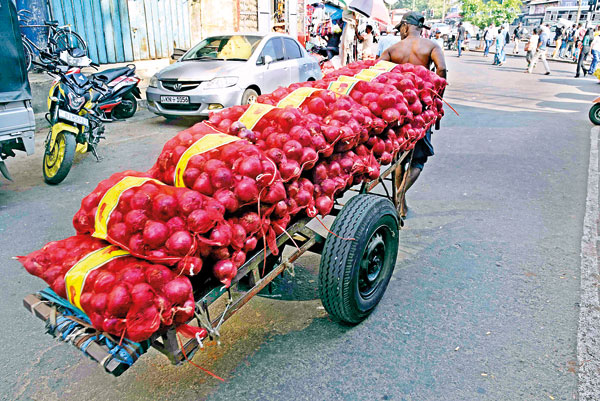News
A ‘rose’ by another name will still retail for up to Rs 400 a kilo
View(s):By Minaza Hassan
Sri Lanka will import mid-sized, rose’ onions from India as a temporary substitute for big onions, said Trade Ministry Secretary A.M.B. Attapattu. These onions are already available but are smaller and substandard in flavour in comparison to the big onions. They are sold at Rs. 350 per kilo at wholesale and Rs. 400 per kilo at retail.
However, shipments of big onions are due from Turkey, China, and the Netherlands as per discussions on Thursday, but they will take time to arrive, Mr. Attapattu said.
In the meantime, red onions imported from India are sold at Rs. 265 per kilo.
“Some consumers buy red onions over rose onions as it is cheaper and there isn’t much demand for rose onions,’’ said chairman and spokesman of the Importers’ Association, Nihal Seneviratne.

For decades, local production had not been able to meet more than 40% of the demand. Pic by Akila Jayawardena
“We are awaiting shipments from China, and we are expecting one vessel to arrive by the end of this month; however, there will not be enough in time for the April New Year.’’
India stopped exports in December. Then, Sri Lanka imported from Pakistan until last Thursday, when they stopped exporting as well due to domestic demand. Imports from China take about 40 days to reach Colombo, and we have to be vigilant about old crops, said Mr. Seneviratne.
However, there are stocks in some markets.
Traders are selling old stocks at higher prices due to export bans in India and Pakistan, Trade Minister Nalin Fernando claimed at a press conference on Thursday.
He also said that despite the imports, onions retailed for between Rs 375 and Rs 400 a kilo.
According to Central Bank data, the price of big onions fluctuated in certain markets, with prices in Pettah rising from Rs. 387 per kilo last Thursday to Rs. 663 per kilo on Monday and then to Rs. 503 per kilo this past Thursday.
| Onion importers, retailers play at will on bare patchThe volume of big onion, a highly perishable, seasonal cash crop grown mainly in Matale and Anuradhapura, is not enough to fulfil local demand, although there is data to show that large-scale imports do create a situation where supply is far greater than demand. For decades, local production had not been able to meet more than 40% of the demand, research data from the Hector Kobbekaduwa Agrarian Research and Training Institute show. The bad consequence is a high import bill and a few local traders and retailers habitually gouging extra profit from imports with government support at crucial times, such as cultural festival periods, when prices gallop. Imports are high in March. Production and the extent cultivated have declined up to 2020 compared with 10 years ago. In 2019, Sri Lanka spent Rs 15 million on imports of big onion and Rs 19 million in 2020, data show. In some years, imports have fulfilled more than 70% of the demand in Sri Lanka. The monthly demand is estimated at 20,000 metric tonnes. In 2020, while the local requirement was 174,704 MT, the supply was 296,344 MT. The surplus was 121,640, according to calculations by Harti research. Research in 2018 estimated that a Big onion is mostly a Yala crop, where the produce is harvested between August and October, and much of it reaches markets in September and October. The bulk of the produce ends up in the Dambulla Dedicated Economic Centre, where research has found that a commission of Rs 2 is charged for less than Rs 80 per kilo. Some of the produce is transported to Thambuththegama. Commercial-scale growers are mainly in Matale, Anuradhapura, the Mahaweli-H region, and Polonnaruwa. In the 11 years to 2020, the average national yield per hectare had fluctuated from a high of 19MT to a low of 13MT, based on data from the agricultural and environment statistics division of the Department of Statistics. | |
The best way to say that you found the home of your dreams is by finding it on Hitad.lk. We have listings for apartments for sale or rent in Sri Lanka, no matter what locale you're looking for! Whether you live in Colombo, Galle, Kandy, Matara, Jaffna and more - we've got them all!

